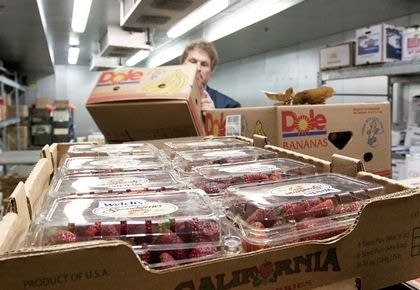Food banks seek new food sources as deliveries rise

Go Deeper.
Create an account or log in to save stories.
Like this?
Thanks for liking this story! We have added it to a list of your favorite stories.
Leftover spaghetti from Grandma's Marathon carbo-loading. Extra lasagna at Duluth hospitals. Milk that public schools can't use over winter break.
All that food is making its way to needy Minnesotans, thanks to a Duluth food bank.
As the number of people seeking help has jumped in recent years, food banks have expanded their capacity and sought new sources of food.
Turn Up Your Support
MPR News helps you turn down the noise and build shared understanding. Turn up your support for this public resource and keep trusted journalism accessible to all.
"Certainly it has lit the fire under us that we need to look at new and innovative ways to feed people in need," said Shaye Moris, executive director of Duluth-based Second Harvest Northern Lakes Food Bank.
According to numbers released recently by Hunger-Free Minnesota, the six Feeding America food banks that serve Minnesota delivered 61.3 million pounds of food in 2010. That's 42 percent more than in 2008. They took it to hundreds of food shelves, as well as to summer food and school pantry programs, which then served struggling Minnesotans.
In search of new food sources, many food banks have increased their "rescue" programs, picking up food that would otherwise be thrown in the trash at retailers like Cub Foods and Target. But the Duluth food bank, which saw distribution rise 33 percent from 2008, has a wider rescue operation than most. It also collects from schools, caterers, even hospitals.
"Hospitals might plan for 300 people during one evening, and low and behold, there are only 250 checked in who need meals," explains Moris. "So they might have 50 meals of lasagna that they'll put in their flash freezer. Our staff will go the next day, pick up that product, and put it right on our delivery truck."
Runners of Grandma's Marathon always provide a big source of food, leaving pounds of spaghetti uneaten at the annual carbo-loading dinner.
"Monday morning, we're down at the Duluth Entertainment Convention Center, picking up the extra spaghetti and sauce," said Moris. "People eat spaghetti for the entire week."
The food bank follows strict food safety rules, said Moris. She has pushed to get "rescue" food from many sources because, she said, there aren't many other new places to get donated food.
"Down in the Twin Cities, there's General Mills and these major manufactures or processors," Moris said. "We have none of that up here in the Northland. Nor do we have a lot of agricultural surplus. So the only way in our region to grow our sources of food is to go after the prepared and the perishable products that are prepared locally."
The food rescue program has helped the food bank keep up with increasing demand, Moris said. She expects it will grow in years to come.
"We see that we're on the tip of the iceberg," she said.
Julie Siple reports on hunger and related issues for Minnesota Public Radio News. MPR is a partner in the Hunger-Free Minnesota project, which helps fund her reporting.


